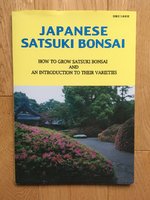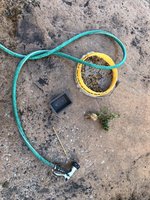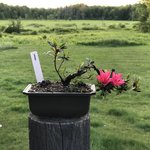@River's Edge is on the mark as usual!
Mr Watanabe’s book is really good. Alexander Kennedy‘s Floral treasures of Japan” is one of my favorite satsuki books as a rookie
@BrierPatch ‘s question kicked off a train of thoughts I wrestle with all year when working on azalea so I’m going to launch a few out here for further cogitation, comments or consideration…. Here goes…
In fact there are plenty of questions that elict different opinions on this forum, debudding is one of these. There are multiple facets.
An important issue with azaleas is maintaining water/sap flow. Preserving the sap flow as is or diverting the sap flow towards foliage growth is a key consideration in most situations.… and avoiding cutting too many roots so the water intake can’t meet the loss from transpiration is a biggy. After all, a tree will die in less then a day if the leaves dehydrate. That’s why repotted trees are kept in shaded situations for 2-3 weeks afterwards.
Damaged roots will divert energy at the expense of the stem, creating a tug of war for resource need. Debudding can make sense in a number of situations.
Yet azaleas aren’t all that frail, if properly handled and the sap flow is maintained, the trees are robust and not meant to be treated like Shrinking Violets. Therein lies the rub. When to debud, partially debud or leave things be?
In practice, full or partial debudding is frequently done to trees in development or, when in refinement during a rest year or to focus resources to specific parts of a tree …. this ensure maximum vegetative growth in these years.
It’s not done in other years, especially when checking the distribution of flower color variations in multi patterned azaleas.
As far as repotting goes there are a couple thoughts on debudding…. here’s a few:
…. the first thought is in a robust tree debudding should not matter, there is plenty of energy to go around. Keep the tree hydrated, out of the sun and all will be fine. If I’m not mistaken, it was Peter Warren, a Japanese bonsai satsuki professional, who stirred things up with this stance on a online lecture a couple years ago.
…. the second thought is debudding should be done whenever a tree is repotted. This is the kind of blanket statement we all like to fall back on as rookies or not. Its easy and keeps one’s tree on a conservative flight path.
…. a third train of thought is when slip potting or repotting done conservatively. In these cases debudding, especially full debudding isn’t necessary. Perhaps the question for this situation would be, “What’s the goals for this tree?”
.
…..a fourth situation….roots severely damaged during repotting …. well, the tree could be now be considered to be in the ER. Factually, if there is not enough active root surface area to uptake water to keep the sap flow going, the tree is going to die now matter what one does. Removing buds is an appropriate effort to decrease the amount of water demands in the stem. Loss of sap from this procedure could throw the tree over the edge, but… this is the ER after all!
….in the last situation I’ll mention, is a tree is not bursting with growth. This could cover a number of cases calling for further investigation a full root and foliage check …These could include trees severely root bound, suffering from root root, blasted with infestation of insects… lacebugs or the like etc. Trees are known to divert energy to reproductive parts as a last gasp, so there is often a plethora of buds. Removing this energy drain could help resolve the situation for a short time while appropriate measures, repotting, rootwashing, fungicide, nematode, insecticide, micronutrients etc are taken.
Cheers
DSD sends












